LTE IoT Market Size and Share
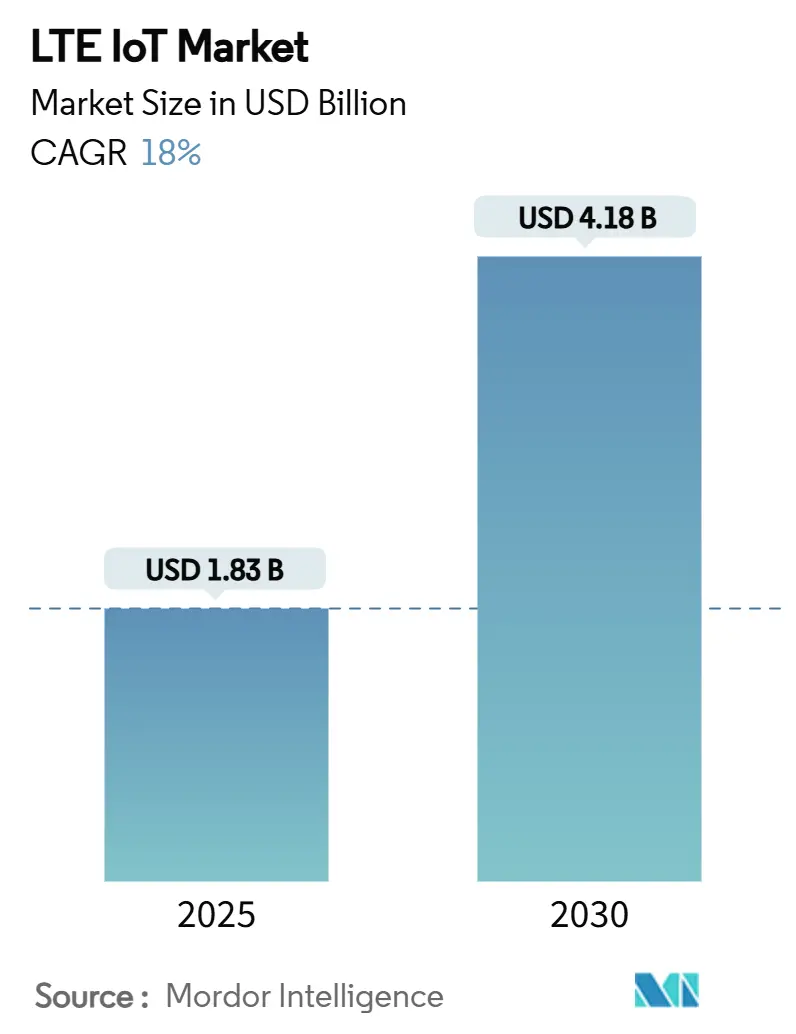
LTE IoT Market Analysis by Mordor Intelligence
The LTE IoT Market size is estimated at USD 1.83 billion in 2025, and is expected to reach USD 4.18 billion by 2030, at a CAGR of 18% during the forecast period (2025-2030).
This rapid growth reflects accelerating 2G and 3G network sunsets, falling low-power cellular module costs, and government smart-meter mandates that lock utilities into licensed-spectrum connectivity. Asia-Pacific (APAC) leads current adoption with 55% revenue share, propelled by China Mobile’s deployment of 1.7 million 5G base stations and 595 million cellular IoT lines. Parallel smart-city spending in the Middle East, exemplified by Qatar’s USD 60 million Lusail City contract, positions the region as the fastest climber at 19.8% CAGR. Enterprises are shifting from outright ownership toward managed connectivity, lifting the managed-services CAGR to 15.4% as operators monetize network slicing and automated provisioning. Demand is strongest in industrial automation today, yet healthcare registers the sharpest upswing thanks to remote patient-monitoring programs riding cellular LPWA backbones.
- By service, professional services held 61% of the LTE IoT market share in 2024, whereas managed services are projected to post the fastest 15.4% CAGR through 2030.
- By product type, NB-IoT dominated with 65% LTE IoT market share in 2024, but LTE-M is forecast to grow at an 18.2% CAGR to 2030.
- By end user, industrial applications captured 30% revenue in 2024; healthcare is advancing at a 17.6% CAGR over 2025-2030.
- By geography, APAC accounted for 55% of 2024 revenue, while the Middle East is set to expand at 19.8% CAGR to 2030.
Global LTE IoT Market Trends and Insights
Drivers Impact Analysis
| Driver | (~) % Impact on CAGR Forecast | Geographic Relevance | Impact Timeline |
|---|---|---|---|
| Sub-USD 4 cellular LPWA module cost target | +4.20% | Global; early uptake in China & Europe | Medium term (2-4 years) |
| Smart utility-meter mandates in >60 states | +3.80% | Europe, North America, APAC | Long term (≥4 years) |
| 2G/3G sunsets driving device migration | +5.10% | Europe & North America first | Short term (≤2 years) |
| 3GPP Rel-17 RedCap power-efficiency gains | +2.30% | Developed markets worldwide | Medium term (2-4 years) |
| Source: Mordor Intelligence | |||
Low-power cellular LPWA modules fall below USD 4
Nordic Semiconductor’s nRF9151 shows how a 64 MHz Arm Cortex-M33 and integrated multimode modem can cut bill-of-materials and approach a sub-USD 4 headline price, encouraging agriculture, logistics, and environmental-sensing deployments that once relied on unlicensed LPWAN. Chinese vendors already quote USD 3 NB-IoT modules for utility meters, reinforcing cost-down momentum . While most global catalogs still list USD 10-15 parts, operators in Europe and APAC have begun subsidizing hardware to accelerate LTE IoT market uptake and lift network utilization.
Smart-meter mandates reinforce cellular connectivity
Over 60 jurisdictions have enacted regulations that oblige gas, electricity, or water utilities to install communicating meters able to upgrade remotely. Telia’s rollout of 2 million Swedish electric meters on NB-IoT and LTE-M cut truck-roll costs and established a 5G-ready distribution grid. Netinium’s SIM-profile orchestration with Telit Cinterion allows remote provisioning, solving the historic lock-in that deterred utilities from wide-area cellular links. [3]Telia Company, “Smart Metering Sweden,” ericsson.comThese programs create multiyear visibility for the LTE IoT market while displacing proprietary mesh networks.
Legacy network sunsets stimulate immediate migration
More than 55 cellular networks were switched off between 2021 and 2025, forcing embedded devices to re-register on LTE-based LPWA protocols. Europe has prioritized 3 G retirement while holding 2G for emergency voice, whereas North America plans synchronized sunsets of both layers. Device makers rush to certify LTE-M and NB-IoT boards that guarantee roaming continuity and battery life, accelerating overall LTE IoT market expansion.
RedCap improves LTE-M energy profile
3GPP Release 17 scales down bandwidth and antenna requirements through RedCap, halving LTE-M power draw and enabling up to 10 Mbps peak rates for mid-tier IoT gadgets. Expected uptake spans smart wearables and process-control sensors that need more than NB-IoT’s tens-of-kilobits yet less than full 5G throughput. Because RedCap operates on existing LTE-M layers until standalone 5G coverage matures, it offers an incremental path to enriched services without ripping out infrastructure.
Restraints Impact Analysis
| Restraint | (~) % Impact on CAGR Forecast | Geographic Relevance | Impact Timeline |
|---|---|---|---|
| Sub-GHz spectrum congestion | -2.10% | Dense urban zones worldwide | Short term (≤2 years) |
| Module price premium versus LoRaWAN/BLE | -1.80% | Cost-sensitive verticals worldwide | Medium term (2-4 years) |
| Source: Mordor Intelligence | |||
Sub-GHz spectrum congestion limits capacity
Multiple LPWAN formats now compete inside finite 700–960 MHz slices. Duty-cycle rules and power caps curb cell density, and network-side interference management costs rise sharply. The FCC opened new 6 GHz indoor allocations in 2024, yet sub-GHz propagation remains critical for underground or rural IoT reach. Operators therefore invest in dynamic-spectrum access and narrowband filtering, adding cost and slowing LTE IoT market rollouts in megacities.
Carbon-footprint rules favor ultra-low-energy designs
Under the EU Energy Efficiency Directive 2023/1791, enterprises must disclose the climate impact of connected assets, nudging them toward sensors able to function for years from tiny batteries or harvested energy. Vodafone’s 2040 net-zero roadmap imposes internal thresholds that may exclude energy-intensive cellular endpoints. This pushes designers to hybrid topologies where NB-IoT transmits data only when thresholds are breached, while a passive local network gathers routine measurements.
Segment Analysis
By Service: Integration complexity sustains professional spend
Professional services generated 61% of LTE IoT market revenue in 2024 through consulting, device certification, and edge-cloud integration projects. Managed-service uptake is forecast to accelerate at 15.4% CAGR as enterprises transfer lifecycle tasks, from SIM logistics to security patching, to specialist providers. Deutsche Telekom's business-to-business arm bundles connectivity with analytics in outcome-based contracts that shift capital budgets into operating fees. [2]Deutsche Telekom, "Capital Markets Day 2024 Transcript," telekom.com Over time, AI-enabled orchestration platforms will trim manual engineering hours, yet the transition itself fuels recurring revenue for managed-service vendors.
Standardized onboarding APIs and eUICC provisioning already shorten pilot phases, but brownfield industrial estates still need bespoke radio-planning and protocol translation. As a result, professional engagements remain pivotal for multiyear retrofits even while new-build projects lean more heavily on managed packages. Managed services in the LTE IoT market are projected to outgrow professional services beyond 2028, with both segments together reinforcing operator stickiness through 2030.
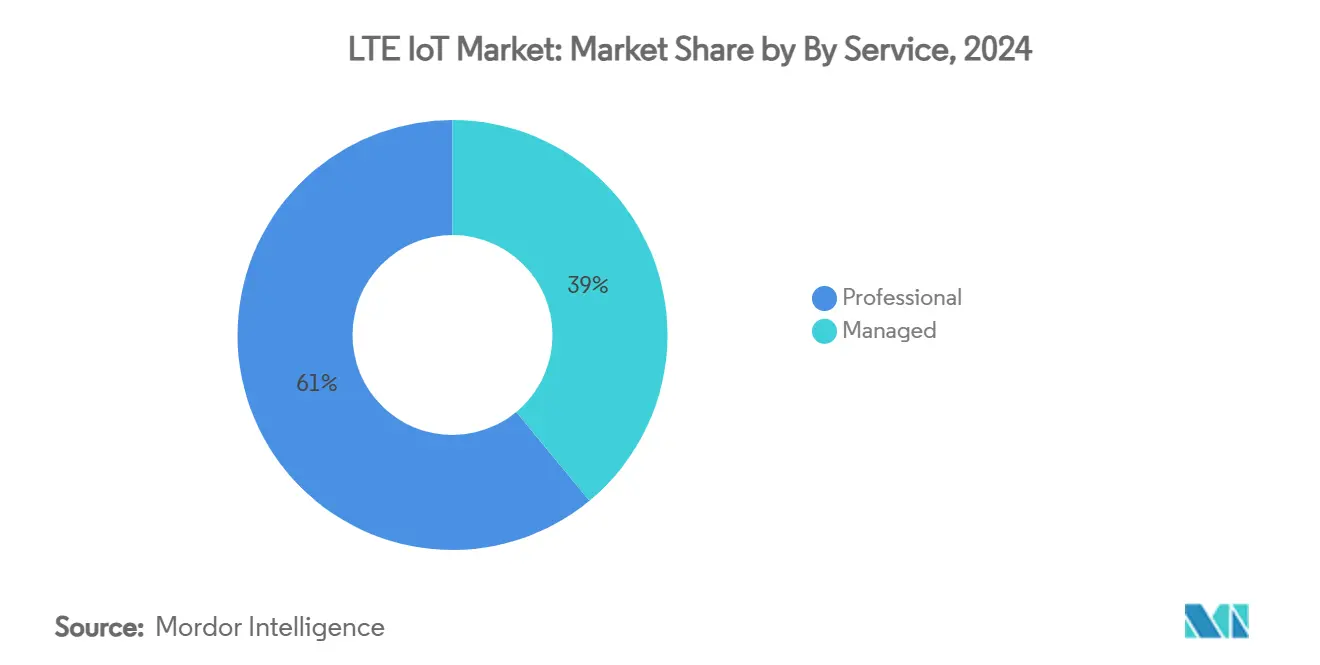
Note: Segment shares of all individual segments available upon report purchase
By Product Type: NB-IoT retains reach while LTE-M gains mobility
NB-IoT accounted for 65% LTE IoT market share in 2024, owing to its 20 dB link-budget advantage and 10-year battery potential in fixed meters. The LTE IoT market size tied to NB-IoT endpoints is projected to climb at 16% CAGR, albeit slower than LTE-M’s 18.2% pace. LTE-M supports voice, mobility, and FOTA block sizes up to 1 MB, making it the preferred choice for fleet trackers and safety wearables. RedCap extensions will further compress its power gap to NB-IoT, while operators harmonize roaming rates.
Hybrid terrestrial–satellite deals illustrate both protocols’ evolution. Quectel’s certified module on Skylo’s NTN adds coverage in maritime or mining corridors, broadening NB-IoT’s footprint. Telit Cinterion, meanwhile, offers dual-mode LTE-M|NB-IoT modules with fallback to GEO satellite for uninterrupted cargo monitoring. The commercial narrative, therefore, shifts from either-or to application-fit, reinforcing coexistence within the LTE IoT industry.
By End User: Healthcare surges while factories keep scale
Industrial automation held 30% revenue share in 2024, driven by predictive-maintenance algorithms that depend on continuous vibration feeds from machinery. Yet healthcare endpoints—ranging from cardiac patches to infusion pumps—will log a 17.6% CAGR through 2030, narrowing the gap. The Monit4Healthy platform demonstrates how edge preprocessing of ECG, EMG, and PPG reduces backhaul traffic before LTE uplink, preserving battery life in ambulatory settings.
Health-sector momentum is reinforced by aging demographics and reimbursement for remote care, while industrial buyers already account for cellular IoT in factory-digitization roadmaps. Retail, agriculture, and consumer electronics deliver ancillary volumes: Saudi vertical-farming projects use NB-IoT soil sensors, and European smart-lock firms bundle LTE-M for backup connectivity. This diversification cushions volatility in any single vertical and expands total LTE IoT market addressability.
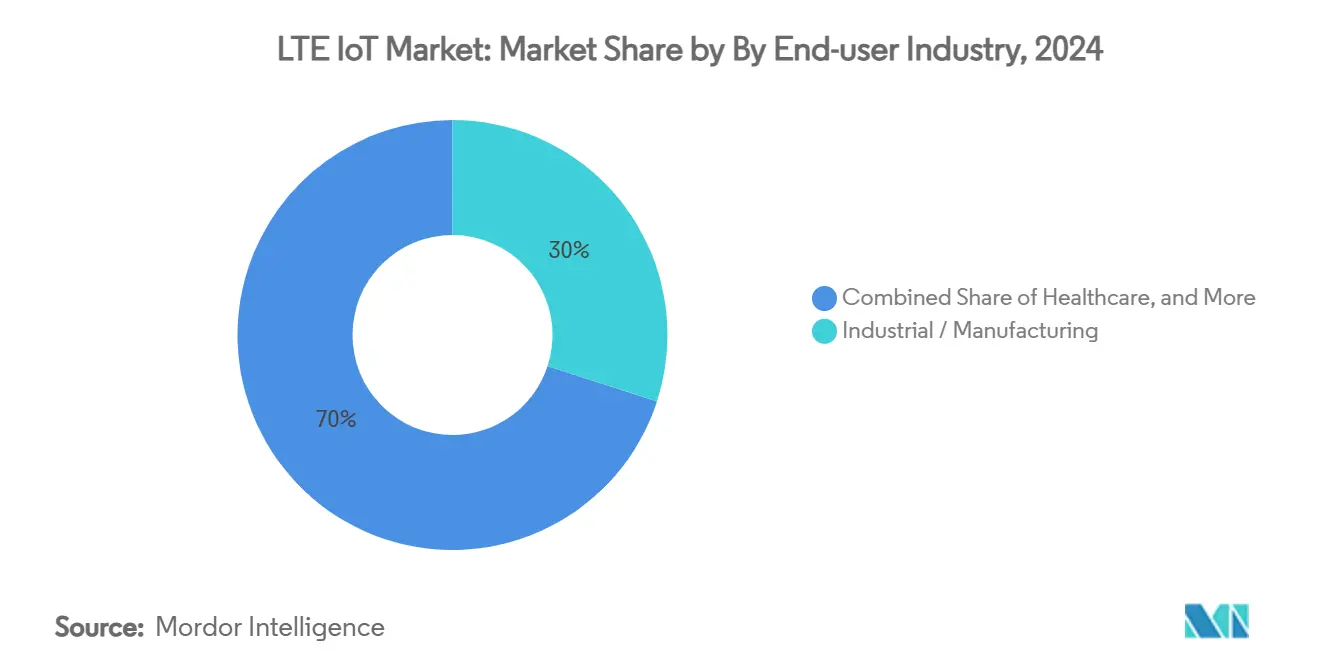
Note: Segment shares of all individual segments available upon report purchase
Geography Analysis
APAC contributed 55% of global revenue in 2024 as China scaled NB-IoT coverage to 100,000 connections per sector and subsidized module production below USD 3. China Mobile booked CNY 723.5 billion (USD 101.2 billion) telecom income in the first three quarters of 2024, underscoring sustained spectrum and capex commitments. Japan and Korea emphasize smart-factory retrofits, while ASEAN nations pilot traffic management and flood-alert systems riding shared LTE backbone infrastructure.
The Middle East is the fastest-expanding sub-region, projected at 19.8% CAGR to 2030. Qatar’s Lusail City program integrates 450,000 residents into a real-time operations center using NB-IoT and LTE-M sensors for lighting, waste, and transport. Saudi Vision 2030 channels petro surplus into agricultural IoT that combats food-security risks, with cellular LPWA linking greenhouse climate controls and drone irrigation.
Europe and North America display steady renewal of legacy meters and industrial gear, aided by stricter carbon accounting and 3G shutdowns. Telia’s conversion of Swedish meters shows the blueprint: swap proprietary PLC for licensed LTE radios, enable eUICC, and guarantee 15-year contracts. o2 Telefónica’s German footprint reported 132.4% year-over-year M2M subscriber growth in Q1 2025, mostly utility driven . Africa and Latin America remain nascent but are leapfrogging fixed lines with direct LTE IoT adoption in asset-tracking and agriculture.
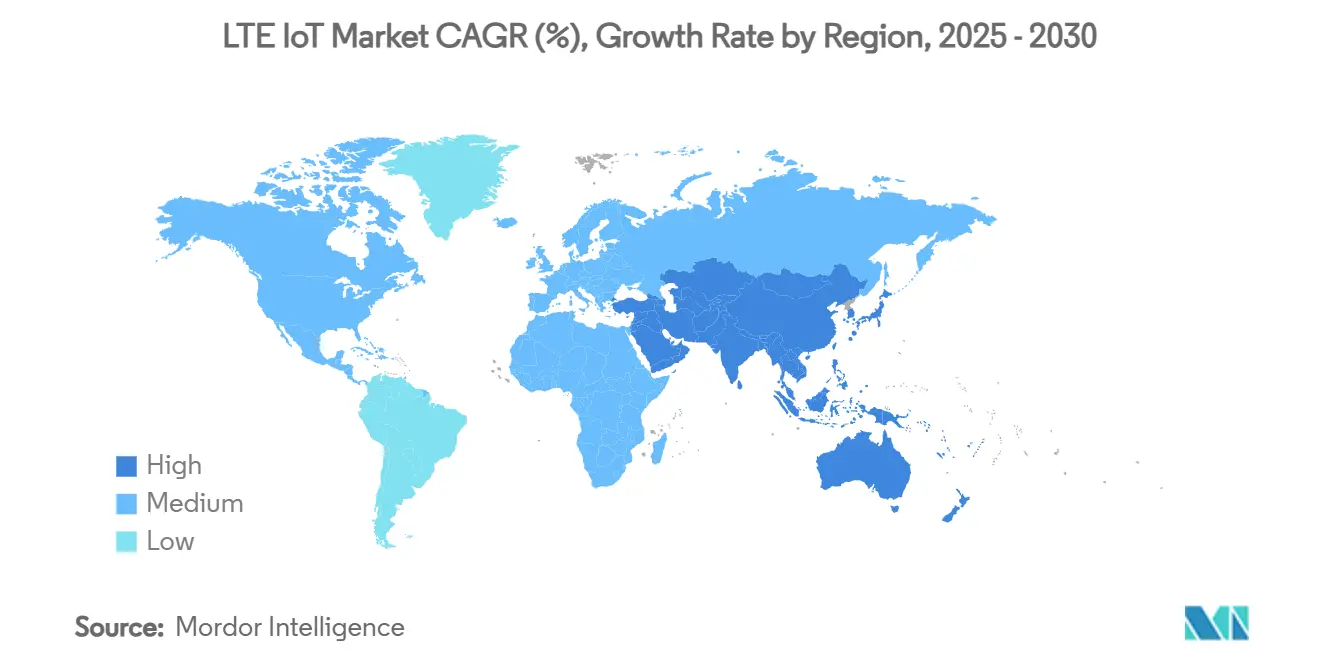
Competitive Landscape
The LTE IoT market is moderately concentrated. Ericsson, Nokia, and Huawei supply multiband radio access networks, but value capture tilts toward cloud-core, SIM management, and analytics layers. Qualcomm leverages its patent pool and Snapdragon X line to license modem IP as well as fabless chipsets for consumer wearables, automotive telematics, and industrial sensors.[1]Qualcomm, “Annual Report 2024,” qualcomm.com Cisco’s IoT Control Center enables operators to carve network slices with differentiated latency and packet-loss guarantees, monetizing connected-vehicle service levels worth an estimated USD 65 billion in subscriptions by 2030.
White-space entrepreneurship thrives at the satellite edge. OQ Technology and Transatel fuse non-terrestrial NB-IoT with terrestrial roaming to safeguard supply-chain visibility in remote regions. Module vendors—Quectel, Fibocom, u-blox—compete on bill-of-materials and integrated GNSS while bankrolling certification across more than 200 carrier profiles. Operators differentiate through end-to-end offers: Vodafone’s Digital Asset Broker layers identity, payment, and ESG scoring atop connectivity, aiming to widen subscription margins without raising average data usage.
Pricing pressure persists. Chinese ODMs undercut established brands by 30-40%, yet multinational buyers often pay a premium for fully documented software stacks and long-term BOM stability. Overall, competitive intensity remains moderate because spectrum licensing, roaming-clearing houses, and 3GPP compliance impose high entry barriers, keeping most new entrants in niche device categories rather than full-stack network services.
LTE IoT Industry Leaders
-
Qualcomm Technologies, Inc
-
Gemalto N.V.
-
u-blox AG
-
Ericsson
-
Cisco (Jasper)
- *Disclaimer: Major Players sorted in no particular order
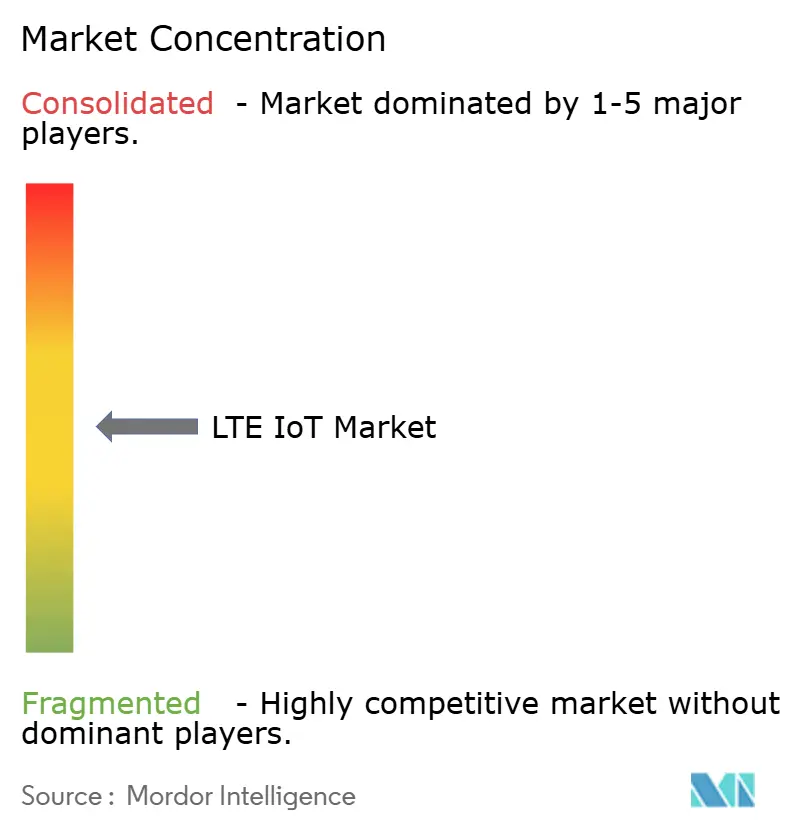
Recent Industry Developments
- March 2025: Vodafone Spain and Ericsson kicked off a four-year standalone 5G core rollout covering 90% of the population to enable network-slicing revenue streams for IoT.
- February 2025: o2 Telefónica deployed Europe’s first commercial 5G Cloud RAN in Germany using Ericsson platforms for scalable IoT workloads
- January 2025: Three UK commissioned a 9 Tbps cloud-native packet core from Ericsson to handle surging LTE and 5G data, including LPWA payloads
- December 2024: Quectel and Skylo unveiled the first non-terrestrial NB-IoT module, extending licensed-spectrum IoT past terrestrial coverage
Global LTE IoT Market Report Scope
Companies are actively working on IoT along with its high growth opportunities in multiple verticals across the market, ranging from healthcare to energy utilities and from automotive to robotics. The size of the 3GPP ecosystem is projected to further drive the commercialization of IoT, with mobile operators, infrastructure suppliers, chipset and module manufacturers, device companies, and development and testing houses supporting new services. In turn, this pushes operators to provide broadband solutions on both mobile networks under the scope of LTE-M and NB-IoT, thereby defining and creating new bundle plans with the help of combined mobile and fixed services.
The LTE IoT Market is segmented by Service (Professional, Managed), Product Type (NB-IoT, LTE-M), End-user Industry (IT & Telecommunication, Consumer Electronics, Retail (Digital Ecommerce), Healthcare, Industrial), and Geography (North America, Europe, Asia-Pacific, and Rest of the World).
The market sizes and forecasts are provided in terms of value (USD million) for all the above segments.
| Professional |
| Managed |
| NB-IoT (Cat-NB1) |
| LTE-M (eMTC Cat-M1) |
| IT and Telecom |
| Consumer Electronics |
| Retail (Digital Commerce) |
| Healthcare |
| Industrial |
| Other Industries |
| North America |
| South America |
| Europe |
| Asia-Pacific |
| Middle East |
| Africa |
| By Service | Professional |
| Managed | |
| By Product Type | NB-IoT (Cat-NB1) |
| LTE-M (eMTC Cat-M1) | |
| By End-user Industry | IT and Telecom |
| Consumer Electronics | |
| Retail (Digital Commerce) | |
| Healthcare | |
| Industrial | |
| Other Industries | |
| By Geography | North America |
| South America | |
| Europe | |
| Asia-Pacific | |
| Middle East | |
| Africa |
Key Questions Answered in the Report
What is the current size of the LTE IoT market?
The LTE IoT market size stood at USD 1.83 Billion in 2025 and is projected to reach USD 4/184 Billion by 2030.
Which region dominates LTE IoT revenue today?
APAC holds 55% of 2024 revenue, largely due to China Mobile’s nationwide NB-IoT and LTE-M rollouts.
Why are managed services growing faster than professional services?
Enterprises prefer outsourcing day-to-day connectivity management, pushing managed-service revenue at a 15.4% CAGR while professional services focus on initial integration work.
How do NB-IoT and LTE-M differ?
NB-IoT excels in stationary, ultra-low-power use cases and captured 65% share in 2024, whereas LTE-M offers mobility and voice features and is growing faster at 18.2% CAGR.
What is RedCap and why does it matter?
RedCap is a 3GPP Release 17 specification that halves LTE-M power consumption while enabling up to 10 Mbps throughput, expanding cellular IoT into mid-tier wearables and industrial sensors.
Which end-user segment is forecast to grow the quickest?
Healthcare is set to expand at a 17.6% CAGR through 2030, driven by remote patient monitoring and home-care programs requiring reliable wide-area connectivity.
Page last updated on:



